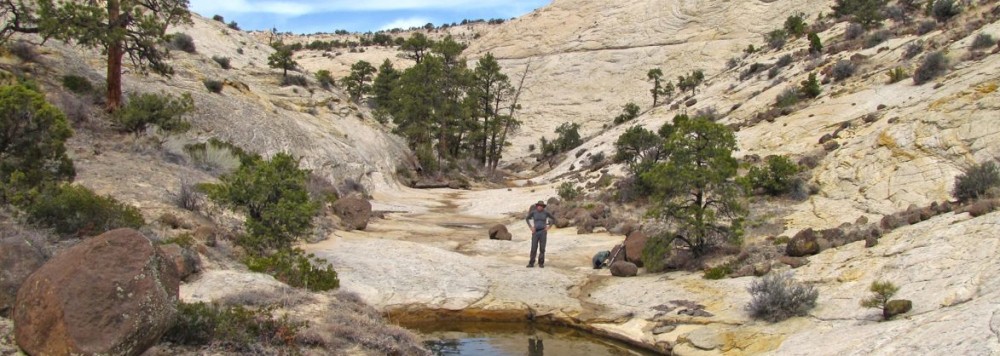 At the end of a sparsely populated paved road which crosses over and terminates at a river estuary, is a newly constructed Charcoal Kiln Museum. Everything excluding fictional the accounting office is outdoors or under that same office. Life-sized characatuers of the people involved in the traditional harvesting and production of charcoal are
At the end of a sparsely populated paved road which crosses over and terminates at a river estuary, is a newly constructed Charcoal Kiln Museum. Everything excluding fictional the accounting office is outdoors or under that same office. Life-sized characatuers of the people involved in the traditional harvesting and production of charcoal are  represented. Evidently major charcoal production has just recently been made obsolescent in southern Thailand as this outdoor museum depicts. One question was unanswered by the museum (It was lacking in any written information or text) was just where was the forest of trees used as raw materials.
represented. Evidently major charcoal production has just recently been made obsolescent in southern Thailand as this outdoor museum depicts. One question was unanswered by the museum (It was lacking in any written information or text) was just where was the forest of trees used as raw materials.
The museum was located in a clearing  of high ground along the densely overgrown Mangrove swamps lining the river. As TigerSong, our cycling companion and personal guide explained, “Mangrove trees are best for making charcoal as they are dense, grow rapidly, and use salt water for hydration.”
of high ground along the densely overgrown Mangrove swamps lining the river. As TigerSong, our cycling companion and personal guide explained, “Mangrove trees are best for making charcoal as they are dense, grow rapidly, and use salt water for hydration.”
This all made sense when considering a similar location we’d seen in Cuba  where the Granma came ashore along the southern coast with 81 rebels and Castro, in November 1956. Running low on fuel, Castro ordered the Granma to run around, unfortunately they landed on a spit of Mangroves where they labored for almost a kilometer to reach solid ground. On that solid ground was a small charcoal producing family whose property and facilities are now memorialized. Cubans must have regarded the Mangroves as a fertile charcoal resource as well. Shown here are only a few of some 20+ life-sized cement statues in a remote riverside park that surely few visitors aside from school children on field trips ever get to see.
where the Granma came ashore along the southern coast with 81 rebels and Castro, in November 1956. Running low on fuel, Castro ordered the Granma to run around, unfortunately they landed on a spit of Mangroves where they labored for almost a kilometer to reach solid ground. On that solid ground was a small charcoal producing family whose property and facilities are now memorialized. Cubans must have regarded the Mangroves as a fertile charcoal resource as well. Shown here are only a few of some 20+ life-sized cement statues in a remote riverside park that surely few visitors aside from school children on field trips ever get to see.
This diversion was on account of our going south to join, the following day, a Trang District bicycle ride with some 300+ cyclists and the local governor who would inaugurate a  cave as an tourist attraction and recognize a very remote school with gifts of bicycles, soccer balls and school supplies. TigerSong took us sightseeing on our way to camp overnight at a police guesthouse aka the municipal police gymnasium. They often arrange accommodation for us cyclists in schools, gyms and temples.
cave as an tourist attraction and recognize a very remote school with gifts of bicycles, soccer balls and school supplies. TigerSong took us sightseeing on our way to camp overnight at a police guesthouse aka the municipal police gymnasium. They often arrange accommodation for us cyclists in schools, gyms and temples.
Highlight of the 200 km weekend camping trip was discovering a tiny two table village restaurant that had the best shrimp I’ve ever eaten. It was served to us as a lark, since we’d ordered chicken fried rice for the four of us, and just as we’d finished and pushed back from the table a platter of this juicy buttery small shrimp appeared.

 We said we were full but after swallowing these shrimp whole and in most cases with the heads on we ordered a second platter and TigerSong went across the road and brought back the very best fresh raw seaweed imaginable. Our very small group included a British family mentioned in earlier posts. Hanna the five-year-old loved the shrimp and
We said we were full but after swallowing these shrimp whole and in most cases with the heads on we ordered a second platter and TigerSong went across the road and brought back the very best fresh raw seaweed imaginable. Our very small group included a British family mentioned in earlier posts. Hanna the five-year-old loved the shrimp and  was like a little bird swallowing the seaweed. What a treat eating Thai foods we’d never think to order. Shrimp platter was 80 baht, about $2.10. Palm oil, garlic, sugar, fresh shrimp and fish sauce. A Roi.
was like a little bird swallowing the seaweed. What a treat eating Thai foods we’d never think to order. Shrimp platter was 80 baht, about $2.10. Palm oil, garlic, sugar, fresh shrimp and fish sauce. A Roi.



















 We aren’t always cycling to site
We aren’t always cycling to site
















